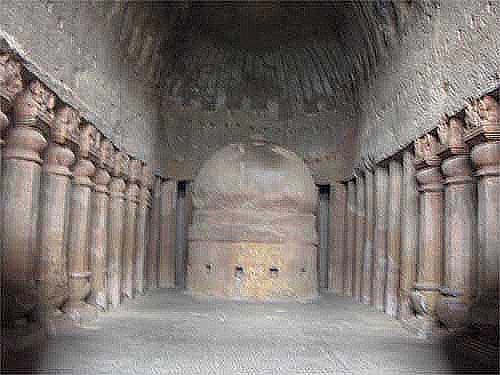
Travel India Kanheri Caves
When we think of caves, we visualize locations in inaccessible places hidden amidst deep forests.

Some caves were carved out in inaccessible places because of fear of prosecution by kings and rulers of different faiths, or due to the desire to remain far away from society, but many were situated on the ancient trade routes and served as halting places for traders and other travellers.
There are some beautiful, ancient, little known caves – Kanheri Caves – about an hour’s drive from Mumbai.
But as the old saying goes ‘there is shadow beneath the lamp’, most Mumbaites do not even know about this place.
The Name
The word Kanheri comes from two Sanskrit words – Kanha meaning Krishna and Giri meaning mountains.
Location
Description

Buddhist caves consist of two main types of structures:
Viharas, or monasteries, single and multiple celled residences of the Buddhist monks.
They were chiseled out of a massive outcrop of basaltic rock.
Most of the caves in Kanheri are Viharas meant for living, study, and meditation.
The larger caves are Chaityagrahas, or halls for worship.
Many of these are lined with intricately carved Buddhist sculptures, reliefs and pillars, and contain rock-cut stupas for congregational worship.
Sculptural art can be seen in Caves like 2, 3, 41, 67, 89, 90, etc.
The most important Cave is Cave No. 3 built during the 6th century.
This has the last of the excavated Chaityagrahas of the Hinayana Order.
This Cave has 34 pillars and is like a colonnaded hall – 28 mtrs x13 mtrs in dimension.
Inside is a 5 mtrs high Dagoba, or stupa, and carvings depicting elephants kneeling and worshipping the stupa.
Cave 1 is an unfinished Chaityagraha, originally planned to have a double-storeyed verandah and a porch, apart from the pillared hall.
The cave is dated to 5th – 6th century A.D. as the pillars with compressed cushion or amalaka top appear generally during this period.
It consists of a huge hall with a front verandah.
There is a statue of the Buddha occupying the central place as in the case of idols in Hindu temples and also a number of cells for Buddhist monks.
Cave 34 is a dark cell and has paintings of the Buddha on the ceiling.
Cave 41 has, besides other sculptures, a figure of the eleven headed Avalokiteshwara.
Cave 67 is a big cell, with the figure of Avalokiteshwara as savior flanked by two female figures in the verandah.
There are also images of the Buddha depicting the miracle of Sravasti.
Kanheri Caves had one of the best rainwater harvesting systems in the world.
There are 86 storage tanks with rock lids some of which have fallen inside and are too heavy to be lifted and placed back on the top.
Farther up the hill are the remains of an ancient water system, canals and cisterns that collected and channeled the rainwater into the huge tanks.
The site can be made a major tourist attraction – as popular as Elephanta and Karla Caves, but sincere efforts are required.
The 6 kms road leading to the Kanheri caves should be repaired and made safe for travellers.
